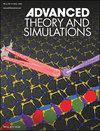M2CO2 (M = Sc, Ti, V) MXenes对氰化氢的选择性捕获和传感性能:第一性原理模型
IF 2.9
4区 工程技术
Q1 MULTIDISCIPLINARY SCIENCES
引用次数: 0
摘要
本研究报告了通过第一性原理密度泛函理论(DFT)计算研究的早期过渡金属基MXenes在检测氰化氢(HCN)方面的高选择性和高性能。在原始的M2C (M = Sc, Ti, V)上,HCN分子通过离子键对表面位置具有很强的化学吸附作用,吸附能在−3.50 ~−4.40 eV之间。电荷密度差图显示,吸附后HCN的C─H键周围电荷聚集,导致其明显伸长。在功能化的M2CO2表面上,HCN分子更倾向于通过静电相互作用与Sc2CO2结合,具有单齿构型,结合能高达0.85 eV,远高于其他表面,这取决于宿主结构的明显终止模式。Sc2CO2在室温下恢复时间较长,约235 s,但灵敏度高达306%,远远优于其他表面。由于成键和反键状态的下移,带隙的轻微减小,即0.072 eV,是这种独特性能的关键。从头算分子动力学(AIMD)模拟揭示了室温下吸附在Sc2CO2表面的HCN在研究时间尺度内的稳定性。本文章由计算机程序翻译,如有差异,请以英文原文为准。
Selective Capturing and Sensing Performance of M2CO2 (M = Sc, Ti, V) MXenes Toward Hydrogen Cyanide: A First‐Principles Modeling
This work reports the high selection and performance of early transition‐metal‐based MXenes toward the detection of hydrogen cyanide (HCN), studied by first‐principles density functional theory (DFT) calculations. On the pristine M2 C (M = Sc, Ti, V), HCN molecules are strongly chemisorptive to surface sites via ionic bonds with adsorption energies ranging from −3.50 to −4.40 eV. The charge density difference plot exhibits a charge accumulation around the C─H bond of HCN after adsorption, leading to its pronounced elongation. On the functionalized M2 CO2 surfaces, HCN molecules prefer binding to Sc2 CO2 via electrostatic interaction with a monodentate configuration and a high binding energy of 0.85 eV, much greater than that on other surfaces, relying on the distinguishing termination pattern of the host structure. Sc2 CO2 shows a relatively long recovery time of ≈235 s at room temperature, however, a high sensitivity of 306% is obtained, which is much superior to that on other investigated surfaces. A slight reduction in bandgap, i.e., 0.072 eV, originating from the down‐shift of both bonding and anti‐bonding states, is the key to this distinctive performance. Ab initio molecular dynamics (AIMD) simulations reveal the stability of adsorbed HCN on the Sc2 CO2 surface within the studied timescale at room temperature.
求助全文
通过发布文献求助,成功后即可免费获取论文全文。
去求助
来源期刊

Advanced Theory and Simulations
Multidisciplinary-Multidisciplinary
CiteScore
5.50
自引率
3.00%
发文量
221
期刊介绍:
Advanced Theory and Simulations is an interdisciplinary, international, English-language journal that publishes high-quality scientific results focusing on the development and application of theoretical methods, modeling and simulation approaches in all natural science and medicine areas, including:
materials, chemistry, condensed matter physics
engineering, energy
life science, biology, medicine
atmospheric/environmental science, climate science
planetary science, astronomy, cosmology
method development, numerical methods, statistics
 求助内容:
求助内容: 应助结果提醒方式:
应助结果提醒方式:


